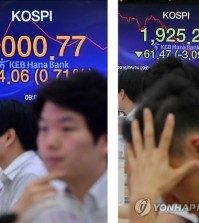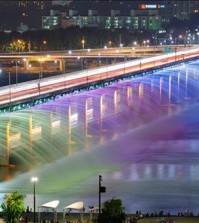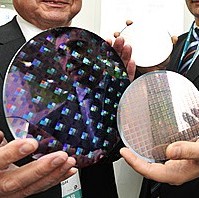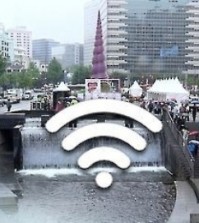- California Assembly OKs highest minimum wage in nation
- S. Korea unveils first graphic cigarette warnings
- US joins with South Korea, Japan in bid to deter North Korea
- LPGA golfer Chun In-gee finally back in action
- S. Korea won’t be top seed in final World Cup qualification round
- US men’s soccer misses 2nd straight Olympics
- US back on track in qualifying with 4-0 win over Guatemala
- High-intensity workout injuries spawn cottage industry
- CDC expands range of Zika mosquitoes into parts of Northeast
- Who knew? ‘The Walking Dead’ is helping families connect
‘Mapping creativity’ hits Seoul
Kaohsiung Design Festival in Taiwan embraces 10 cities
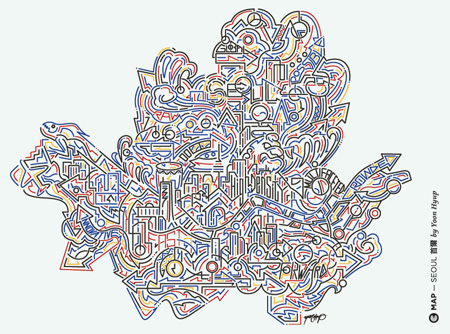
Seoul’s creative map is designed by Yoon Hyup. The unique graphic image of the capital is part of the CREATIVE CITIES project of the feature international showcase of this year’s Kaohsiung Design Festival at the Pier-2 Art Center in Taiwan in coincidence with the Asia Pacific Cities Summit from Dec. 13 to Jan. 12 in 2014. (Courtesy of Kaohsiung Design Festival)
By Chung Ah-young

From top, Psy, bibimbap, hanbok and soju are among the icons representing Seoul. Various graphic icons showing the symbolic food, drinks, iconic figures, buildings, road signs, and currency of the city to highlight the similarities and differences from other cities will be seen at this year’s Kaohsiung Design Festival.
(Courtesy of Kaohsiung Design Festival)
What should be the internationally recognized icon for Seoul? There are numerous candidates, but still Psy and “bibimbap” are among the most likely to represent the capital.
The city was designated as a UNESCO City of Design in 2010 due to keeping its cultural heritage in harmony with contemporary creativity. But the younger generations of creative artists and designers are still eager to bring in new ideas.
The diverse aspects of Seoul from its people, culture, art, fashion and tradition to products can be seen at the CREATIVE CITIES project as part of the feature international showcase of this year’s Kaohsiung Design Festival at the Pier-2 Art Center in Taiwan in coincidence with the Asia Pacific Cities Summit from Dec. 13 to Jan. 12 in 2014.
Over 250 artists, designers, musicians, entrepreneurs, and others across 10 cities, including Seoul, in the Asia-Pacific region, are taking part in a visual multimedia extravaganza for this creative project.
The exhibition showcases 10 cities across the region that are now leading this wave of change ― Kaohsiung, Bangkok, Beijing, Hong Kong, Kuala Lumpur, Manila, Seoul, Singapore, Sydney and Tokyo ― along with 1,200 projects produced by their creators.
The project features “creative maps” which show people from these cities, along with projects, products and places, recommended by creators living there.
Designed by Yoon Hyup, a Korean designer from littergram, Seoul’s creative map is a unique graphic image of the capital. The map is in line with his former work “Unlimited Path.”
“I want to express that Seoul can create various feelings. I think the more you know the city, the more attractive it becomes. The dynamic energy of Seoul is expressed in Korean traditional patterns such as ‘vine cloud’ and ‘wind cloud’ using five colors. I tried to strike a balance between Seoul’s iconic image and this pattern form,” he said.
The designer said that the city is full of the diversity of the crowd with a dynamic spirit. “Seoul is a city that constantly changes,” he said.
For the exhibition, the City Center booth for Seoul shows the creative theme of the city and visitors can see the Creators Map and look in detail at works related to this theme. The exhibition presents details of specific places or projects recommended such as Leeum Samsung which is actually designed by star architects such as Rem Koolhaas, Hongdae Area, World Jewellery Museum, and the Seoul Urban Art Project working under the theme of destruction and development. Also the section focuses on the GRAPHIC magazine which is becoming an international publication and Samsung Electronics which are flexing their muscles beyond Seoul and Korea.
Various graphic icons that represent the city to highlight the similarities and differences from other cities will vividly show the symbolic food, drinks, iconic figures, buildings, road signs, and currency of the city.
“CREATIVE CITIES is a visual collection of people, places and projects that shape the city’s creative scene. We have invited the creators to help us map the creativity and stories of their cities,” said exhibition curator Jackson Tan.
The exhibition will showcase its multi-screen Cities Index and a unique Creators Map made up of over 12,000 images.
Visitors can tour each city and see the future creative city at the Creator’s Vision section and exchange opinions on it at the (C)Free-zone.
Shih Che, director general of the Kaohsiung’s bureau of cultural affairs, said the exhibition will bring together work from across the region and showcase different interpretations of what it means to be a creative city.
“A city has a variety of different poses when we look at it from different perspectives. We attempt to understand the creative connections within the Asia-Pacific region, and explore how cities with seemingly similar cultural backgrounds are gradually transformed over time. We want to figure out how local people see themselves and their own city, as well as how they want foreign people to see them and their city,” he said.







